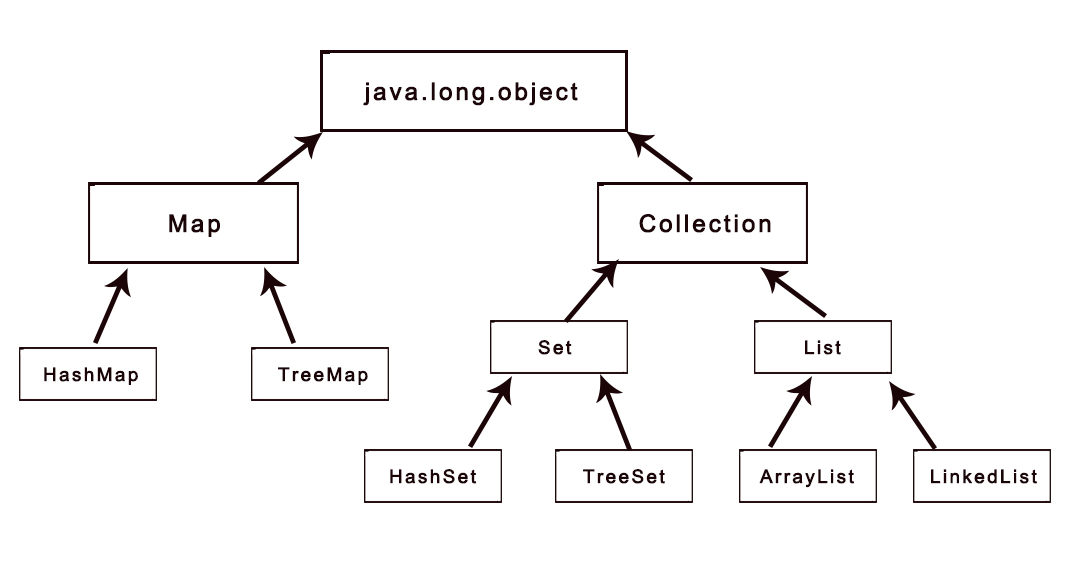Java语言的java.until包中提供了一些集合类,这些集合类又被称为容器。说到集合就会想到数组,集合类与数组的不同之处是,数组的长度是固定的,集合的长度是可变的;数组用来存放基本数据类型,集合从来存放对象的引用。常用的集合有List集合,Map集合与Set集合,其中List与Set实现了Collection接口,他们的继承关系如下图:

Map接口的常用方法:
Map接口提供了将键 映射到 值的对象。一个映射不能包含重复的键;每个键最多只能映射到一个值。Map的常用方法如下:
| 方法 | 返回值 | 功能描述 |
| put(key,value) | Object | 向集合中添加指定的key与value的映射关系 |
| get(key) | Object | 如果存在指定的键对象,则返回该对象对应的值,否则返回null |
| containsKey(key) | boolean | 如果此映射包含指定键的映射关系,则返回true |
| containsValue(value) | boolean | 如果此映射将一个或多个键映射到指定值,则返回true |
| keySet() | Set | 返回该集合中的所有键对象组成的Set集合 |
| values() | Collection | 返回该集合中所有值对象形成的Collection集合 |
| size() | int | 返回该集合中所有对象的个数 |
| remove(key) | 清除该集合中指定键对象的内容 | |
| clear() | 清除该集合中所有对象的内容 |
写法:
Map方法是不能直接被new出来的,所以想要使用Map方法,就要采用Map中的HashMap。写法为:
Map<String,String> list = new HashMap<String,String>();
下面就举个例子:
public static void main(String[] args) { Map<String,String> list = new HashMap<String,String>(); list.put("zs", "张三家的狗狗"); list.put("lisi","李四家的小狗"); String d = list.get("lisi"); System.out.println(d); Set keys = list.keySet(); Iterator it = keys.iterator(); while(it.hasNext()){ Object obj = it.next(); //System.out.println(obj); Object v = list.get(obj); System.out.println(v); } String s = (String)list.get("zs"); System.out.println(s); System.out.println(list.containsKey("zs")); System.out.println(list.containsValue("hello world")); System.out.println(list.size()); list.remove("zs"); System.out.println(list.size()); list.clear(); System.out.println(list.size()); }
输出结果为:
李四家的小狗 李四家的小狗 张三家的狗狗 张三家的狗狗 true false 2 1 0
Collection接口中List的常用方法:
List接口继承了Collection接口,因此包含Collection中的所有方法。但是他还有一些适合于自身的常用方法。如下:
| 方法 | 返回值 | 功能描述 |
| add(int index,Object obj) | void | 用来向集合中的指定索引位置添加对象,集合的索引位置从0开始 |
| get(int index) | Object | 用来获取指定索引位置的对象 |
| contains() | boolean | 如果列表包含指定的元素,则返回true |
| indexOf(Object obj) | int | 该方法返回列表中对象第一次出现的索引位置,如果集合中不包含该元素,则返回-1 |
| lastIndexOf(Object obj) | int | 该方法返回列表中对象最后一次出现的索引位置,如果集合中不包含该元素,则返回-1 |
| set(int index,e element) | Object | 用指定元素替换列表中指定位置的元素,返回以前在指定位置的元素 |
| subList(int formIndex,int toIndex) | LIst | 获取从索引formIndex到toIndex之间的元素对象 |
| size() | int | 返回该集合中所有对象的个数 |
| remove(int index) | Object | 用来移除集合中指定索引位置的对象 |
| clear() | 清除该集合中所有对象的内容 | |
| iterator | 返回按适当顺序在列表的元素上进行迭代的迭代器。 |
此时我们需要注意的是:List接口中适合于自身的方法都与索引有关。
写法:
同样的道理,list也是不能被直接new出来的,所以我们也要使用list的ArrayList。写法如下:
List<String> list = new ArrayList<String>();
下面举个例子:
public static void main(String[] args){ List<String> list = new ArrayList<String>(); list.add("helll world"); list.add("good morning"); list.add("merry christmas"); list.add("happy new year"); for(int i=0;i<list.size();i++){ System.out.println(list.get(i)); } }
输出结果为:
helll world good morning merry christmas happy new year
这里是采用索引号来进行遍历输出所有内容的,下面再一个例子来了解一下迭代器iterator及其他内容的使用:
public static void main(String[] args){ List<String> list = new ArrayList<String>(); list.add("吕布"); list.add("赵云"); list.add("典韦"); list.add("关羽"); list.add("张飞"); list.set(4, "马超"); Iterator<String> it = list.iterator(); while(it.hasNext()){ System.out.println(it.next()); } System.out.println(list.size()); Object obj ="吕布"; list.remove(obj); System.out.println(list); list.remove("赵云"); System.out.println(list.size()); System.out.println(list.get(2)); list.clear(); System.out.println(list); }
输出结果为:
吕布 赵云 典韦 关羽 马超 5 [赵云, 典韦, 关羽, 马超] 3 马超 []
Collection中Set接口的常用方法:
Set集合由Set接口和Set接口的实现类组成。Set接口继承了Collection接口,因此包含了Collection接口的所有方法。如下:
| 方法 | 返回值 | 功能描述 |
| add(Object obj) | boolean | 如果此Set集合中尚未存在指定的元素,则添加此元素 |
| get(int index) | Object | 用来获取指定索引位置的对象 |
| removeAll(Collection c) | boolean | 在Set集合中移除包含在指定Collection中的元素 |
| size() | int | 返回该集合中所有对象的个数 |
| remove(Object obj) | boolean | 将指定的参数对象移除集合 |
| clear() | 清除该集合中所有对象的内容 | |
| iterator | 返回按适当顺序在列表的元素上进行迭代的迭代器。 |
由于Set集合中不允许存在重复值,因此可以使用Set集合中的addAll()方法,将Collection集合添加到Set集合中并除掉重复值。
来个例子:
public static void main(String[] args){ List<String> list = new ArrayList<String>(); list.add("apple"); list.add("banana"); list.add("pear"); list.add("apple"); Set<String> set =new HashSet<String>(); set.addAll(list); Iterator<String> it = set.iterator(); while(it.hasNext()){ System.out.println(it.next()+" "); } }
输出结果为:
banana
apple
pear